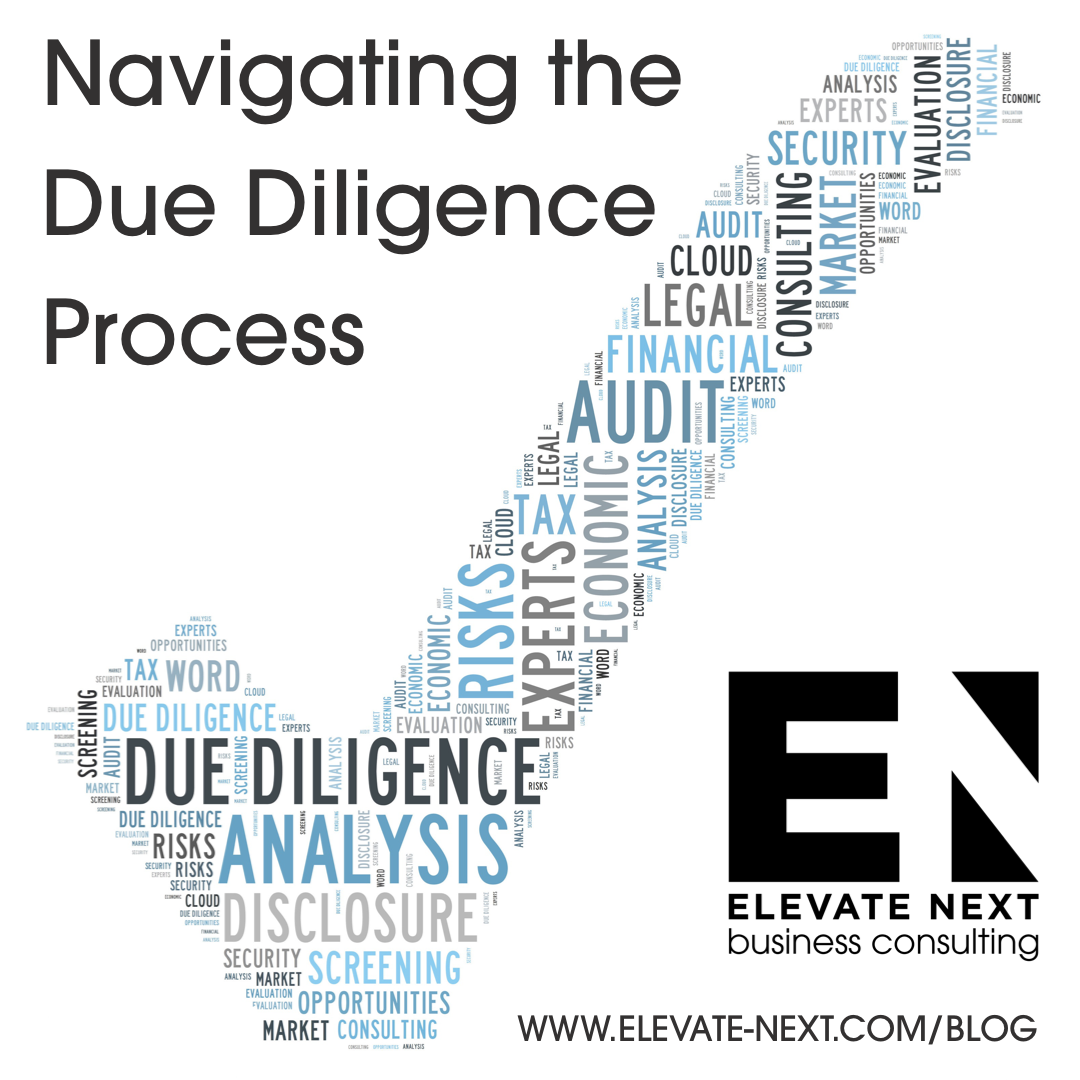Navigating the Due Diligence Process: What Should You Expect?
Mergers & Acquisitions Part II
Due diligence is about confirming the risks and assessing the degree of risk for an acquiring company during the acquisition process. The due diligence (DD) phase is the last part of the negotiation process – usually, the toughest part - between the buyer and seller.
By the time the DD phase begins, the following groundwork has already been completed:
The buyer and seller have signed a confidential disclosure agreement (CDA). Initial discussions on company valuation and expectations between the buyer and the seller may already have occurred.
The seller has shared several years of financial statements and the general company information requested by the seller.
With this information, the buyer’s acquisition team has developed its preliminary valuation of the company; identified key financial metrics (return on investment (ROI), internal rate of return (IRR), payback period, etc.); defined the deal structure (stock or asset purchase); and proposed a purchase price.
The business case for the acquisition has been presented to and approved by the acquiring company’s ownership and Board of Directors.
The lead negotiator in the acquisition team has extended the approved purchase price offer and proposed deal structure to the buyer, who may or may not already have had a valuation in mind.
The buyer and seller have agreed on the purchase price and deal structure, and a non-binding Letter of Intent (LOI) has been signed.
(For more information on how to prepare your firm for sale, read my previous blog: Positioning Your Business for Sale: What Privately Held Companies Often Overlook.)
For the buyer, the DD process is expensive and complex to manage, involving numerous internal and external parties. Your legal, accounting, and tax advisors are reviewing the seller's books. Depending on the profile of the acquisition target and the industry, and the magnitude of the deal, you may need to perform other types of audits. You may engage additional parties in the process to obtain real estate and property appraisals or perform environmental, information technology (IT), research & development (R&D), regulatory, and operations/engineering audits. The seller will have engaged, at a minimum, their own legal, accounting, and tax advisors.
The due diligence phase is the hardest part of the acquisition process. This is when pressure is highest and the most intense negotiating takes place. You, as the buyer, are committed enough to spend some real cash on a potentially lengthy due diligence effort.
To put it in perspective, you are:
Assessing the deal’s degree of risk, which is then factored into the purchase price you have agreed upon with the seller in the Letter of Intent (LOI), and
Developing a remediation plan for each risk assessed as part of the integration of the acquired company. This remediation planning will add requirements of and/or present financial risks to the seller at closing.
Your due diligence process is always on a tight timeline – no matter the project's scope – and each of the factors above can delay your closing date. By the time you start the due diligence process, there is usually no backing out of it unless something completely unexpected – a deal breaker for the buyer – is uncovered. An example of this would be findings of fraud or other illegal activity, or that a key synergy assumption you factored into the company valuation was no longer valid.
The legal and business teams will have been drafting the Sale and Purchase Agreement (SPA) in parallel with the DD process. Negotiations to change the purchase price (a loss in value due to newly assessed risk) or the deal structure (to implement the remediation plan) are especially difficult because the seller is already on the defensive amid an auditor invasion and is likely to feel her leverage is weakened. The seller has also had the normal course of business interrupted. You, the buyer, may have the upper hand at this point, especially if you have restricted bidding through a non-compete for a set period.
The seller has also likely been trying to keep the potential sale of their company hidden from some or all of their employees to reduce the risk of employee turnover if the deal falls apart. Key employees have been identified at this point and may be involved in the audit process. This creates a sensitive situation in which any delays or hiccups in the due diligence process will be exacerbated.
Your human resources team will work with legal advisors to draft employment agreements for the key employees of the acquired company. With the seller’s approval, the acquisition team must decide if these key employee agreements are negotiated before closing or at closing. Coming to mutually agreeable terms with these key employees requires careful negotiations at the right time, which is usually the most strained part of the SPA negotiation between you and the seller.
Imagine you are evaluating an acquisition opportunity in a seasonal industry, and the purchase price you and the seller agree upon depends on closing the deal at a specific time of year. If your DD timeline slides even a little, you could lose the profits you forecast in your valuation. You are also at risk of renewed price negotiations with the seller due to a valuation decrease.
The acquisition team has several simultaneous project management roles:
Keeping the Board of Directors informed;
Negotiating with the seller;
Managing key stakeholders in the DD process at their own company; and
Ensuring that the auditors and evaluators of the seller’s company are delivering on their respective scopes of work and sticking to the DD project timeline.
To avoid a deal killer in the acquisition process, you, as the buyer, can do the following:
Manage the expectations of the seller from the beginning: clearly and realistically outline the acquisition process (no sugar coating!); explain your corporate culture and its quirks; discuss some of the sticking points and difficulties that may come up, and how those will be handled.
Agree to a joint due diligence project timeline and closing date, which should be outlined in the Letter of Intent, with the seller.
Develop an approved purchase price range before beginning the negotiation process: the “walk away” price, the expected (or acceptable price), and the “we hit the jackpot” price. This gives the acquisition team more flexibility in the various stages of negotiation with the seller.
Always work to frame the final agreement as a win-win for both parties.
If you are the lead negotiator, have a team member on hand to listen during your negotiations with the seller. If you are speaking, you are not listening!
“The aim of listening is to ascertain what the other side is trying to achieve… ‘Every time you share an opinion, you give out information about yourself… In contrast, a good listener, by keeping quiet, gains an edge over his or her counterpart.”
Make sure your acquisition prospect list is fully aligned with the buyer’s corporate strategy by vetting your list early and often with key internal stakeholders. By doing this, you avoid moving too far along in the process with the seller before realizing you have no corporate support.
As tough as the negotiations during an acquisition project may be, always act with professional integrity and be straightforward. Manage and protect your reputation – both as an individual and as a representative of your company. You will be “selling” both to the seller and the buyer, whether that is your own company or a client. A failed deal may still further your career if both parties remember your work as being of the highest caliber.
Feel free to contact us if you would like to explore process improvements for your team or any aspect of mergers and acquisitions. Elevate Next has experience that includes international mergers and acquisitions, as well as working with smaller companies on process improvements, growth, and development.
Subscribe to the Elevate Next newsletter for small- to medium-sized business tips, client features, and updates on our next blog describing best practices for post-merger integration planning.






Big tech may be sinking deeper into internet ‘enshittification,’ but not every platform is following that path. Patreon CEO Jack Conte argues that the internet can still be a place where creativity, community, and genuine human connection come first. By designing algorithms that fund art - not ads - and keeping humans, not engagement traps, in control, platforms can provide a healthier digital ecosystem.